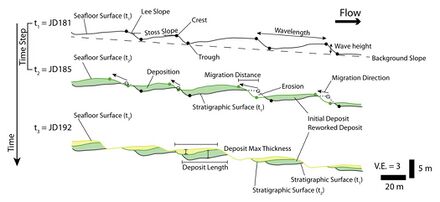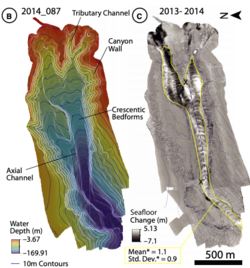Earth:Cyclic steps
Cyclic steps are rhythmic bedforms associated with Froude super-critical flow instability.[1][2] They are a type of sediment wave,[3] and are created when supercritical sediment-laden water (turbidity currents) travels downslope through sediment beds.[4] Each ‘step’ has a steep drop, and together they tend to migrate upstream.[5] On the ocean floor, this phenomenon was first shown to be possible in 2006, although it was observed in open-channel flows over a decade earlier.[6][2][1] Geological features appearing to be submarine cyclic steps have been detected in the northern lowlands of Mars in the Aeolis Mensae region, providing evidence of an ancient Martian ocean.[7]
Formation
There are many parameters which govern the formation of cyclic steps; bed slope, bed porosity, erosion resistance, sediment concentration, and flow rate all play a role.[2] Tilting flumes can be used to create cyclic steps in subaerial laboratory conditions, provided the Froude number is high enough. If the Froude number is lower than required, antidunes will form instead.[8][5] Additionally, if the sediment is too fine then chute-and-pool features will form.[8] In subaqueous conditions, most of the work has traditionally been in building mathematical, rather than physical, models of cyclic step formation.[9][5] However, cyclic steps have attracted increasing scientific attention in the past decade, and numerous real world examples of cyclic steps have now been found.[10]
Cyclic steps can be categorized by the rate at which sediment is deposited (the aggradation rate) on different parts of the steps. The categorization concerns the difference in rate on the stoss (flow-facing) and lee (flow-opposing) sides of the feature. Type-1 cyclic steps have more lee erosion than there is stoss aggradation, Type-2 have a roughly equal amount of lee erosion and stoss aggradation, and Type-3 has aggradation on both sides. Type-1 cyclic steps play an important role in canyon formation. Type-2 cyclic steps have been created in the laboratory, in contrast to Type-3 which is common on the sea floor but is harder to create in laboratory conditions - it was first made experimentally in 2013.[5][11] Types 1, 2, and 3 are also called 'falling', 'transportational', and 'climbing', respectively.[10] Laboratory work has successfully created all three types of cyclic steps in open-channel flows.[10]
Relation to other bedforms
In density flows, antidunes can turn into cyclic steps by wave breaking.[12] Fluid flow is Froude-supercritical over the entirety of antidunes, whereas the flow alternates between the sub- and super-criticality over cyclic steps (with hydraulic jumps between cycles). Additionally, cyclic steps tend to have a much larger wavelength-to-flow-thickness ratio and a higher suspension index (ratio of shear velocity to sediment settling velocity). Antidunes are typically unstable (although they can be made stable in laboratory conditions), in contrast to cyclic steps. Despite these differences, it is not uncommon for researchers to incorrectly label a cyclic step as an antidune.[10] Cyclic steps also have similarities to chute-and-pool features. Like cyclic steps, chute-and-pool flows undergo hydraulic jumps,[12] although the flow does not undergo repeated transitions from sub- to super-critical. When the flow remains subcritical over the whole feature, ripples and dunes form instead.[10]
Examples
Attention on real world cyclic steps has mostly been focused on the ocean floor and at river deltas.[10] Several submarine cyclic steps have been discovered off the coast of California, such as those in the underwater canyons Monterey Canyon[13][14] and Eel Canyon.[15] They have also been discovered in the South China Sea, at the South Taiwan shoal and the West Penghu submarine canyons. The cyclic step structure at the South Taiwan shoal is the longest ever observed (as of 2015), consisting of 19 steps and ranging over 100 kilometres (62 mi).[16] They have also been discovered in the Japan Sea at the Toyama deep-sea channel.[17][18] On Mars, they have been observed at Aeolis Mensae.[7] At prodeltas (the portion of a river delta furthest from shore[19]), cyclic steps have been observed in the Mediterranean.[3] The wavelength of prodelta cyclic steps tends to be an order of magnitude smaller than their seafloor counterparts; the Mediterranean cyclic steps have a wavelength ranging from 20 to 100 metres (66 to 328 ft) whereas submarine cyclic steps are typically measured in kilometers.[3]
While no modern examples have been found, cyclic steps can also form within rivers. Geologic evidence from the Cambrian-Ordovician Potsdam Group strata indicates that the Quebec Basin once possessed this type of cyclic step.[20] Glaciolacustrine cyclic steps have also been found in modern Quebec.[21] Cyclic steps can also form along underwater volcanos, such as those in the Punta del Rosario fan,[22] as well as along carbonate slopes and under bedrock streams.[23][10][24] Cyclic steps do not need to form underwater - wind can cause them too. Katabatic winds may have caused cyclic steps to form on the ice sheet of Antarctica,[25][10] and are actively forming cyclic steps at Mars’ poles.[26]
References
- ↑ 1.0 1.1 "Coherent Flow Structures in Open Channels | Wiley" (in en-us). https://www.wiley.com/en-us/Coherent+Flow+Structures+in+Open+Channels-p-9780471957232.
- ↑ 2.0 2.1 2.2 Kostic, Svetlana (2011-04-01). "Modeling of submarine cyclic steps: Controls on their formation, migration, and architecture". Geosphere 7 (2): 294–304. doi:10.1130/GES00601.1. ISSN 1553-040X. Bibcode: 2011Geosp...7..294K.
- ↑ 3.0 3.1 3.2 Urgeles, Roger; Cattaneo, Antonio; Puig, Pere; Liquete, Camino; De Mol, Ben; Amblàs, David; Sultan, Nabil; Trincardi, Fabio (2011-03-01). "A review of undulated sediment features on Mediterranean prodeltas: distinguishing sediment transport structures from sediment deformation" (in en). Marine Geophysical Research 32 (1): 49–69. doi:10.1007/s11001-011-9125-1. ISSN 1573-0581. Bibcode: 2011MarGR..32...49U. https://doi.org/10.1007/s11001-011-9125-1.
- ↑ Shao, Da-Li; Fan, Guo-Zhang; Wang, Hai-Qiang; Ma, Hong-Xia; Zuo, Guo-Ping; Ding, Liang-Bo; Cai, Zheng; Li, Wei-Qiang (2021-02-01). "3D anatomy and flow dynamics of net-depositional cyclic steps on the world's largest submarine fan: a joint 3D seismic and numerical approach" (in en). Petroleum Science 18 (1): 10–28. doi:10.1007/s12182-020-00512-3. ISSN 1995-8226.
- ↑ 5.0 5.1 5.2 5.3 Cartigny, Matthieu J.B.; Postma, George; Van Den Berg, Jan H.; Mastbergen, Dick R. (2011-02-15). "A comparative study of sediment waves and cyclic steps based on geometries, internal structures and numerical modeling" (in en). Marine Geology 280 (1–4): 40–56. doi:10.1016/j.margeo.2010.11.006. ISSN 0025-3227. Bibcode: 2011MGeol.280...40C.
- ↑ Kostic, Svetlana; Parker, Gary (2006-09-01). "The response of turbidity currents to a canyon–fan transition: internal hydraulic jumps and depositional signatures". Journal of Hydraulic Research 44 (5): 631–653. doi:10.1080/00221686.2006.9521713. ISSN 0022-1686. https://doi.org/10.1080/00221686.2006.9521713.
- ↑ 7.0 7.1 Kostic, Svetlana; Smith, Isaac B. (2018-11-15). "Water on Mars: Do submarine cyclic steps exist on the red planet?". Progress in Earth and Planetary Science 5 (1): 76. doi:10.1186/s40645-018-0225-2. ISSN 2197-4284. Bibcode: 2018PEPS....5...76K.
- ↑ 8.0 8.1 Taki, Kazuo; Parker, Gary (2005-09-01). "Transportational cyclic steps created by flow over an erodible bed. Part 1. Experiments". Journal of Hydraulic Research 43 (5): 488–501. doi:10.1080/00221680509500147. ISSN 0022-1686. https://doi.org/10.1080/00221680509500147.
- ↑ Mastbergen, D. R. (1989). "Zand-watermengselstromingen - het storten van zand onder water, 6: Wiskundig model terras-vormig stort" (in en). Z0299. https://repository.tudelft.nl/islandora/object/uuid%3A345548c4-b077-4c57-a605-c66b648f4712.
- ↑ 10.0 10.1 10.2 10.3 10.4 10.5 10.6 10.7 Slootman, Arnoud; Cartigny, Matthieu J.B. (2020-02-01). "Cyclic steps: Review and aggradation-based classification" (in en). Earth-Science Reviews 201: 102949. doi:10.1016/j.earscirev.2019.102949. ISSN 0012-8252. Bibcode: 2020ESRv..20102949S. https://www.sciencedirect.com/science/article/abs/pii/S0012825218301363.
- ↑ Yokokawa, M.; Kyogoku, A.; Kotera, A.; Izumi, N. (2013-12-01). "Cyclic steps incised on experimental bedrock". AGU Fall Meeting Abstracts 24: EP24B–06. Bibcode: 2013AGUFMEP24B..06Y. http://adsabs.harvard.edu/abs/2013AGUFMEP24B..06Y.
- ↑ 12.0 12.1 Spinewine, Benoit; Sequeiros, Octavio E.; Garcia, Marcelo H.; Beaubouef, Rick T.; Sun, Tao; Savoye, Bruno; Parker, Gary (2009-08-01). "Experiments on Wedge-Shaped Deep Sea Sedimentary Deposits in Minibasins and/or on Channel Levees Emplaced by Turbidity Currents. Part II. Morphodynamic Evolution of the Wedge and of the Associated Bedforms" (in en). Journal of Sedimentary Research 79 (8): 608–628. doi:10.2110/jsr.2009.065. ISSN 1527-1404. Bibcode: 2009JSedR..79..608S. https://pubs.geoscienceworld.org/sepm/jsedres/article/79/8/608/145276/Experiments-on-Wedge-Shaped-Deep-Sea-Sedimentary.
- ↑ Fildani, A.; Normark, W.R.; Kostic, S.; Parker, G. (2006). "Channel formation by flow stripping: large-scale scour features along the Monterey East Channel and their relation to sediment waves". Sedimentology 53 (6): 23. doi:10.1111/j.1365-3091.2006.00812.x. Bibcode: 2006Sedim..53.1265F. http://pubs.er.usgs.gov/publication/70028939.
- ↑ Englert, Rebecca G.; Hubbard, Stephen M.; Cartigny, Matthieu J. B.; Clare, Michael A.; Coutts, Daniel S.; Hage, Sophie; Hughes Clarke, John; Jobe, Zane et al. (June 2021). "Quantifying the three‐dimensional stratigraphic expression of cyclic steps by integrating seafloor and deep‐water outcrop observations.". Sedimentology 68 (4): 1465–1501. doi:10.1111/sed.12772. ISSN 0037-0746. https://doi.org/10.1111/sed.12772.
- ↑ Lamb, Michael P.; Parsons, Jeffrey D.; Mullenbach, Beth L.; Finlayson, David P.; Orange, Daniel L.; Nittrouer, Charles A. (2008-03-01). "Evidence for superelevation, channel incision, and formation of cyclic steps by turbidity currents in Eel Canyon, California" (in en). GSA Bulletin 120 (3–4): 463–475. doi:10.1130/B26184.1. ISSN 0016-7606. Bibcode: 2008GSAB..120..463L. https://pubs.geoscienceworld.org/gsa/gsabulletin/article/120/3-4/463/2267/Evidence-for-superelevation-channel-incision-and.
- ↑ Zhong, Guangfa; Cartigny, Matthieu J. B.; Kuang, Zenggui; Wang, Liaoliang (2015-05-01). "Cyclic steps along the South Taiwan Shoal and West Penghu submarine canyons on the northeastern continental slope of the South China Sea" (in en). GSA Bulletin 127 (5–6): 804–824. doi:10.1130/B31003.1. ISSN 0016-7606. Bibcode: 2015GSAB..127..804Z. https://pubs.geoscienceworld.org/gsa/gsabulletin/article-abstract/127/5-6/804/126106/Cyclic-steps-along-the-South-Taiwan-Shoal-and-West.
- ↑ Spinewine, Benoit; Sequeiros, Octavio E.; Garcia, Marcelo H.; Beaubouef, Rick T.; Sun, Tao; Savoye, Bruno; Parker, Gary (2009). "Experiments on wedge-shaped deep sea sedimentary deposits in minibasins and/or on channel levees emplaced by turbidity currents. Part II. Morphodynamic evolution of the wedge and of the associated bedforms". Journal of Sedimentary Research 79 (8): 608–628. doi:10.2110/jsr.2009.065. ISSN 1527-1404. Bibcode: 2009JSedR..79..608S. https://experts.illinois.edu/en/publications/experiments-on-wedge-shaped-deep-sea-sedimentary-deposits-in-mini-2.
- ↑ Nakajima, Takeshi; Satoh, Mikio; Okamura, Yukinobu (1998-05-01). "Channel-levee complexes, terminal deep-sea fan and sediment wave fields associated with the Toyama Deep-Sea channel system in the Japan Sea" (in en). Marine Geology 147 (1–4): 25–41. doi:10.1016/S0025-3227(97)00137-0. ISSN 0025-3227. Bibcode: 1998MGeol.147...25N. https://www.sciencedirect.com/science/article/abs/pii/S0025322797001370.
- ↑ "GEOL342 - Sedimentation and Stratigraphy". https://www.geol.umd.edu/~jmerck/geol342/lectures/10b.html.
- ↑ Lowe, David G.; Arnott, R. W. C. (2016-06-01). "Composition and Architecture of Braided and Sheetflood-Dominated Ephemeral Fluvial Strata In the Cambrian–Ordovician Potsdam Group: A Case Example of the Morphodynamics of Early Phanerozoic Fluvial Systems and Climate ChangeD.G. LOWE AND R.W.C. ARNOTTBRAIDED AND EPHEMERAL FLUVIAL STRATA OF THE POTSDAM GROUP" (in en). Journal of Sedimentary Research 86 (6): 587–612. doi:10.2110/jsr.2016.39. ISSN 1527-1404. https://pubs.geoscienceworld.org/sepm/jsedres/article-abstract/86/6/587/321132/Composition-and-Architecture-of-Braided-and.
- ↑ Poiré, Antoine G.; Lajeunesse, Patrick; Normandeau, Alexandre; Francus, Pierre; St-Onge, Guillaume; Nzekwe, Obinna P. (2018-04-15). "Late-Quaternary glacial to postglacial sedimentation in three adjacent fjord-lakes of the Québec North Shore (eastern Canadian Shield)" (in en). Quaternary Science Reviews 186: 91–110. doi:10.1016/j.quascirev.2018.02.013. ISSN 0277-3791. Bibcode: 2018QSRv..186...91P. https://www.sciencedirect.com/science/article/abs/pii/S0277379117304948.
- ↑ Romagnoli, C.; Casalbore, D.; Bosman, A.; Braga, R.; Chiocci, F.L. (2013-04-01). "Submarine structure of Vulcano volcano (Aeolian Islands) revealed by high-resolution bathymetry and seismo-acoustic data" (in en). Marine Geology 338: 30–45. doi:10.1016/j.margeo.2012.12.002. ISSN 0025-3227. Bibcode: 2013MGeol.338...30R. https://www.sciencedirect.com/science/article/abs/pii/S0025322712003118.
- ↑ Betzler, Christian; Lindhorst, Sebastian; Eberli, Gregor P.; Lüdmann, Thomas; Möbius, Jürgen; Ludwig, Juliane; Schutter, Ilona; Wunsch, Marco et al. (2014-10-01). "Periplatform drift: The combined result of contour current and off-bank transport along carbonate platforms" (in en). Geology 42 (10): 871–874. doi:10.1130/G35900.1. ISSN 0091-7613. Bibcode: 2014Geo....42..871B. https://pubs.geoscienceworld.org/gsa/geology/article/42/10/871/131403/Periplatform-drift-The-combined-result-of-contour.
- ↑ Izumi, Norihiro; Yokokawa, Miwa; Parker, Gary (2012). "Cyclic Step Morphology Formed on Bedrock". Journal of Japan Society of Civil Engineers, Ser. B1 (Hydraulic Engineering) 68 (4): I_955–I_960. doi:10.2208/jscejhe.68.I_955. https://www.jstage.jst.go.jp/article/jscejhe/68/4/68_160/_article/-char/en.
- ↑ Fahnestock, Mark A.; Scambos, Ted A.; Shuman, Christopher A.; Arthern, Robert J.; Winebrenner, Dale P.; Kwok, Ron (2000). "Snow megadune fields on the East Antarctic Plateau: Extreme atmosphere-ice interaction" (in en). Geophysical Research Letters 27 (22): 3719–3722. doi:10.1029/1999GL011248. ISSN 1944-8007. Bibcode: 2000GeoRL..27.3719F. https://agupubs.onlinelibrary.wiley.com/doi/abs/10.1029/1999GL011248.
- ↑ Smith, Isaac B.; Holt, John W.; Spiga, Aymeric; Howard, Alan D.; Parker, Gary (2013). "The spiral troughs of Mars as cyclic steps" (in en). Journal of Geophysical Research: Planets 118 (9): 1835–1857. doi:10.1002/jgre.20142. ISSN 2169-9100. Bibcode: 2013JGRE..118.1835S. https://agupubs.onlinelibrary.wiley.com/doi/abs/10.1002/jgre.20142.
 |





